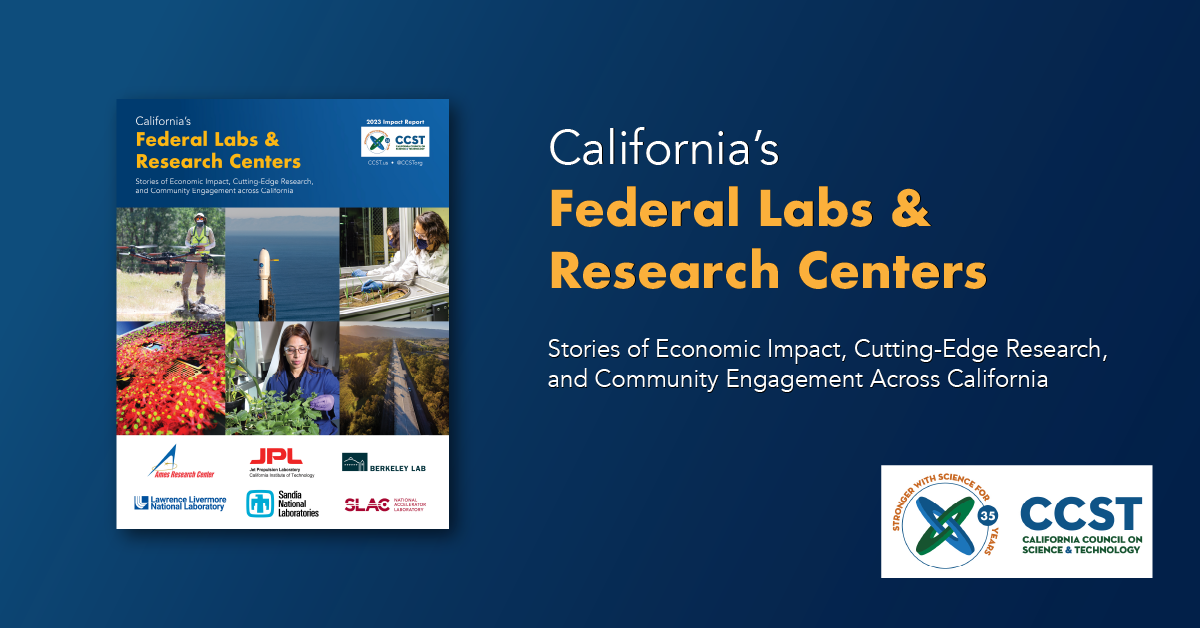Deputy Director
Report: California’s NASA and DOE Labs Are Leading the Charge Toward a More Resilient and Sustainable Future
May 4, 2023 | CCST Newsroom, Federal Research in California, Press Releases

FOR IMMEDIATE RELEASE
Media Contact: [email protected]
SACRAMENTO, Calif.—A new impact report released by the California Council on Science and Technology (CCST) showcases the groundbreaking work of NASA field centers and Department of Energy national laboratories in California, featuring stories of how they are leveraging their world-class expertise and technologies to invest in California’s resilience to disasters.
The report, “California’s Federal Labs and Research Centers: Stories of Economic Impact, Cutting-Edge Research, and Community Engagement Across California,” is available to download or view on CCST’s website.
Through research (on Earth and beyond) and community engagement, California’s federal labs and research centers bring large-scale solutions to some of our biggest challenges – including climate change, clean energy, disaster resilience, and national security.
Their cutting-edge initiative is a clear reminder of the world-class expertise and resources that each lab offers California’s policymakers, strengthening the state’s position as a global leader on science and technology. The 2023 impact report can help Capitol staff navigate the tremendous resources spread across federal labs and science centers in California.
“The unique nature of our federal labs and research centers puts them in an ideal position to pursue research and development in service of the public good,” says CCST CEO Amber Mace. “Whether it is developing tools to make our energy grid more resistant to external threats, using satellites to monitor emerging disasters to aid first responders, or deploying new technologies to decarbonize the transportation sector, the breakthroughs developed in these labs continue to benefit millions of Californians every year.”
A global leader in science and technology research and innovation, California is home to a diverse range of federal labs, science centers, and field stations, across several U.S. agencies, departments, and bureaus. Six of these entities are CCST Partner Institutions, highlighted in the report:
National Aeronautics and Space Administration (NASA) Field Centers:
- NASA’s Ames Research Center (NASA Ames)
- NASA’s Jet Propulsion Laboratory (NASA JPL)
U.S. Department of Energy (DOE) National Laboratories:
- Lawrence Berkeley National Laboratory (Berkeley Lab)
- Lawrence Livermore National Laboratory (LLNL)
- Sandia National Laboratories, California (Sandia, California)
- SLAC National Accelerator Laboratory (SLAC)

The report profiles each institution—together representing billions of dollars of Federal investment and tens of thousands of jobs—providing specific examples of their work on issues of state, federal, and global importance. Examples of their work range from reducing carbon emissions and fighting fire with drones, to national security, laser power, electric grid resilience, the bioeconomy, and more.
Some examples include:
- Lawrence Berkeley National Lab is using hydrogen fuel cells to help industries decarbonize and keep the electric grid resilient during periods of low renewable energy production
- SLAC National Accelerator Lab will collaborate with Stanford University in a research project led by the National Alliance for Water Innovation aimed at developing energy-efficient technologies to decontaminate nontraditional water sources for diverse uses.
- NASA’s Jet Propulsion Lab is working with nonprofit Carbon Mapper to be able to survey methane emissions to detect leaks in infrastructure from agriculture, landfills, and oil and gas utilities, aiding facilities operators in repairing these leaks.
- Sandia National Laboratories, well known for designing reliable and resilient microgrids for military bases and vital city services, are now working with NASA to design a microgrid for an American moon base.
- A new method developed at Lawrence Livermore National Lab improves the extraction and separation of rare-earth elements—a group of 17 chemical elements critical for technologies such as smart phones and electric car batteries—from unconventional sources in a more environmentally friendly way.
- The Scalable Traffic Management for Emergency Response Operations, or STEReO, team at NASA’s Ames Research Center, is designing software and communication tools to help disaster responders work more safely and efficiently—including the use of drones.
To learn more, visit ccst.us/report/labsimpact.
###
About the California Council on Science and Technology
The California Council on Science and Technology is a nonpartisan, nonprofit organization established via the California State Legislature in 1988. We engage leading experts in science and technology to advise State policymakers, ensuring that California policy is strengthened and informed by scientific knowledge, research, and innovation.




